[ad_1]
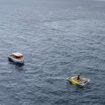
Go World Travel is reader-supported and may earn a commission from purchases made through links in this piece.
Staring out the thick, acrylic window of Viking’s small submarine, I can’t see much in the nearly pitch-black waters of the Southern Ocean. I’m just starting to imagine what might be looming in the darkness when our pilot, Niko Bragge, tells us he’s going to flip on the vessel’s exterior lights.
“Everything you’re going to see today will be the first time it’s been seen by human eyes,” he says.
Our group—six total passengers, plus the pilot—is submerged more than 400 feet below the water’s surface just off Cuverville Island, a small, ice-covered outpost in the Antarctic Peninsula that’s home to a thriving gentoo penguin colony.
While the water temperature outside is hovering just above freezing, we’re warm and dry inside the high-tech, yellow, personal submersible nicknamed Ringo, a not-at-all-subtle nod to The Beatles.
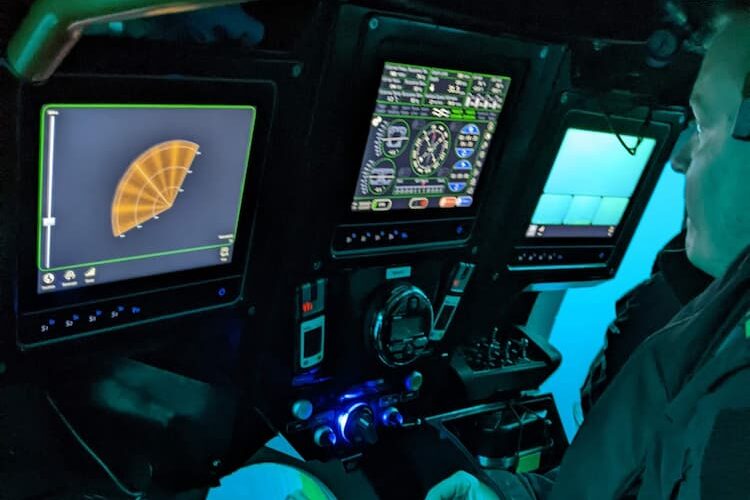 Controlling the submarine. Photo by Sarah Kuta
Controlling the submarine. Photo by Sarah Kuta
The submarine is one of four U-Boat Worx Cruise Sub 7 MK II vessels that travelers can experience while sailing aboard Viking’s two new purpose-built sister expedition ships, Viking Polaris and Viking Octantis, which began cruising to Antarctica, South America and the Great Lakes last year.
Offered for $499 per person as an add-on excursion, the submarine dives offer travelers a unique—and memorable—opportunity to comfortably explore the frigid waters surrounding the ship. Here’s what it’s like to ride in one.
Waiting to dive
Like all excursions on expedition cruises to Antarctica, the dives are weather-dependent and, during the first half of my 13-day sailing aboard the 378-passenger Viking Polaris in mid-January, we’d already endured several days of too-rough seas that meant the subs couldn’t launch safely.
I worried that time would run out and I wouldn’t get to experience the submersible before the ship headed north across the Drake Passage to return to Ushuaia, Argentina.
But, finally, on one of our last days exploring the peninsula, I got the call in my stateroom. Could I make it down to Deck A in the next 15 minutes?
I raced around my room to gear up, donning my thick wool base layers, my waterproof pants, my bright red Viking-issued coat, my emergency life vest and my waterproof boots.
After rushing down two flights of stairs to the ship’s lowest level, I found several other prospective submarine passengers already waiting, just as eager as I was to finally go underwater.
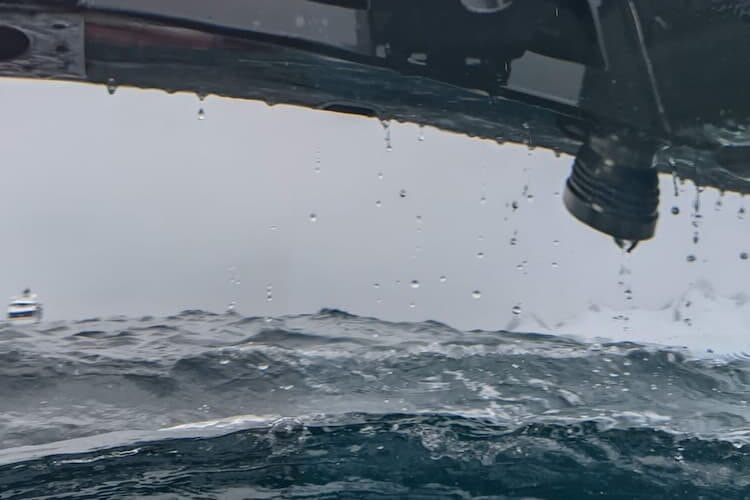 Submerging under the water. Photo by Sarah Kuta
Submerging under the water. Photo by Sarah Kuta
Getting to the submarine
An expedition team member handed each of us a lanyard with a little numbered tab to wear around our necks, which corresponded to our assigned seats once onboard the submarine.
(To help ensure the submersibles are balanced and safe, Viking weighs all interested guests at the beginning of the voyage, then carefully pieces together the submarine schedule and seating chart accordingly.)
The submarine, meanwhile, was already in position a few hundred yards away from the ship, along with its small, accompanying safety boat that would remain topside while we explored beneath the surface.
To reach the submersible, we clambered from the Polaris into an inflatable Zodiak boat bobbing in the waves and headed across the water.
When we arrived, Bragge was standing atop the submarine’s exposed platform, which was about a foot above the water’s surface. He talked us through how to safely board the submarine.
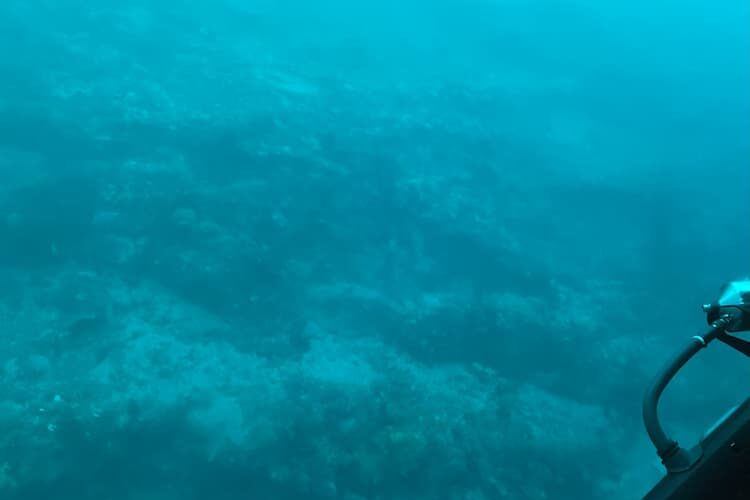 Into the depths below. Photo by Sarah Kuta
Into the depths below. Photo by Sarah Kuta
Boarding the vessel
Once it was my turn, I grabbed Bragge’s arm in a tight sailor’s grip—as we’d been shown during our first nightly briefing onboard the Polaris—and stepped onto the platform. As Bragge had instructed, I stepped down into the open hatch, climbed down the ladder and more or less crawled to my seat.
Once we were all inside and seated—three on one side, three on the other, with the pilot’s station right in the middle—Bragge closed the hatch and began a lengthy series of safety checks, which admittedly helped quell my nerves.
Communicating via radio to the two crew members in the safety boat on the surface, he confirmed several sensor readings and tested the vessel’s systems to ensure they were working properly. Then, he rotated our chairs outward so we could enjoy the full 270-degree view out the bubble-shaped windows.
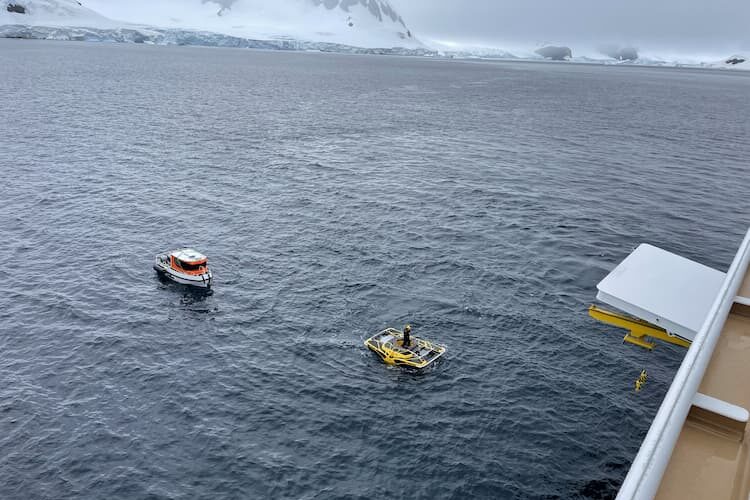 A view of the submarine entrance from above. Photo by Sarah Kuta
A view of the submarine entrance from above. Photo by Sarah Kuta
Diving deeper
With everything up to par, he engaged the submarine’s thrusters and it slowly began to descend. I looked up through the window and watched as the water fully engulfed the submersible.
As we descended deeper, the water became darker until, eventually, it was nearly opaque. When we reached our final depth of 402 feet, Bragge flipped on the lights and I gasped. The submarine was facing a sloped, underwater wall covered with colorful creatures.
Among them, I spotted sea spiders, sea sponges, starfish, as well yellow and orange algae and brown seaweed. We moved horizontally along the ridgeline, taking in the rich biodiversity that can persist—and, even, thrive—in an environment that seemed so unsuited for life.
After 45 awe-inspiring minutes or so, we started our ascent, with Bragge communicating regularly with the crew on the surface. We emerged into the gray afternoon light and found a Zodiak waiting to take us back to the ship.
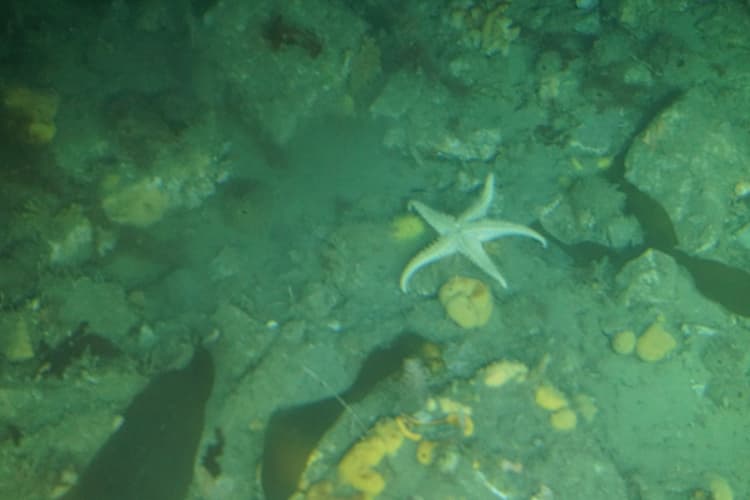 A sea star on the sea floor. Photo by Sarah Kuta
A sea star on the sea floor. Photo by Sarah Kuta
Supporting science
For me—and, likely, my fellow passengers—the submarine dive was a once-in-a-lifetime experience on an already bucket-list cruise to the White Continent.
But in addition to giving travelers an exhilarating new perspective of Antarctica, Viking’s sophisticated personal submersibles are also helping with scientific research.
The cruise line’s onboard geochemist, Brandi Revels, is using the vessels to help get core samples of the rocks on the seafloor as part of her postdoctoral research project, which focuses on sequestering carbon amid climate change.
The underwater forays are also engaging everyday people in citizen science—and travelers are observing some incredible creatures, including a rarely-seen giant phantom jellyfish, which Viking’s scientists published a paper on earlier this year.
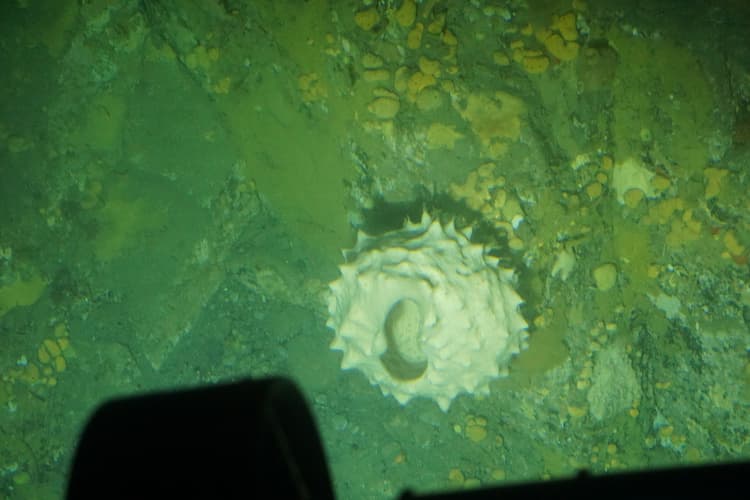 More life on the sea floor. Photo by Sarah Kuta
More life on the sea floor. Photo by Sarah Kuta
Research on the White Continent
More broadly, the submarines reflect Viking’s serious commitment to scientific research. The cruise line is involved in an array of partnerships and projects with the National Oceanic and Atmospheric Administration, the National Weather Service, the Norwegian Institute for Water Research, Happywhale, iNaturalist and the Cornell Lab of Ornithology, to name a few.
With support from Viking, onboard PhD scientists are studying everything from microplastics in the Southern Ocean to seabird distribution on the continent and more.
Guests can get in on the action, too, such as by documenting their bird sightings on the citizen science platform eBird, attending a variety of engaging lectures and, of course, keeping their eyes peeled for elusive aquatic life while diving in a submarine.
“During each voyage, our guests participate in real, significant science,” says Damon Stanwell-Smith, Viking’s head of science and sustainability. “Our scientific approach centers on having the platform to explore, with the personnel to interpret what is found.”
If You Go
Submarine dives are available as excursions on Viking’s expedition cruise itineraries. Two of the submarines are onboard the Viking Polaris, while the other two are on Viking Octantis, which sail various itineraries in the Great Lakes, Canada, South America and Antarctica; the ships also take passengers on longitudinal world cruises.
The submarine dive excursion costs $499 per person and lasts approximately one hour. Six passengers can dive at a time, accompanied by one pilot.
The 13-day Antarctic Explorer itinerary, which I sailed aboard, started with flights to Buenos Aires, followed by an overnight stay with all other Viking guests making the journey at Hilton Buenos Aires.
Then, Viking’s guests boarded chartered flights to Ushuaia, Argentina, the southernmost city in the world and the main departure port for Antarctic cruises. From there, we boarded the ship, which crossed the Drake Passage and explored various landing sites on the Antarctic Peninsula.
On my sailing, the ship visited Damoy Point, Cuverville Island, Detaille Island, Peterman Island and Fournier Bay.
But each sailing is different: Viking is a member of the International Association of Antarctic Tour Operators, which helps schedule and coordinate landing times, dates and locations on the peninsula among all participating cruise lines.
In addition to the submarines, Viking’s expedition ships are also equipped with kayaks, inflatable Zodiak boats and special operations boats for excursions.
The Antarctic cruise season runs from November to February.
Inspire your next adventure with our articles below:
Author Bio: Sarah Kuta is a writer and editor based in Longmont, Colorado. She writes about travel, food and beverage, science, sustainability, history and other topics. Her work has appeared in Conde Nast Traveler, Robb Report, Food & Wine, NBC News, Lonely Planet, Tripadvisor, Smithsonian Magazine, the Denver Post, 5280 Magazine, the Toronto Star and other publications. She holds a journalism degree from Northwestern University.
[ad_2]
Source link
Jarastyle – #Explored #Antarctica #SubmarineHeres
Courtesy : https://www.goworldtravel.com/i-explored-antarctica-by-submarine-heres-what-it-was-like/?utm_source=rss&utm_medium=rss&utm_campaign=i-explored-antarctica-by-submarine-heres-what-it-was-like

